|
Puglia, `the heel of the boot' of Italy, is off the usual tourist track; at least as far as British visitors go. It is known to be rich in orchids, especially on the Gargano peninsula, and despite quite a packed itinerary covering the south, centre and north of the province, we had opportunities for some orchid spotting during our week there.
10th April Matera
The first sighting is a bit of a surprise. The town of Matera is famous for 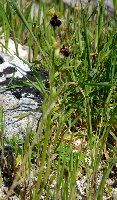 its ancient cave dwellings bored into the side of a limestone gorge, in an area known as The Sassi. This is the its ancient cave dwellings bored into the side of a limestone gorge, in an area known as The Sassi. This is the 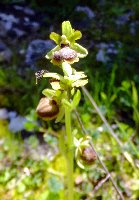 oldest continuously inhabited site in Europe, and up to 3000 lived here without modern services right up to the 1970s. The hillside is a maze of paths and stairs between the houses, and it was just over a low wall that the first orchids Ophrys , was seen. It was a little tricky taking the photos leaning over the wall, and trying to focus on the flowers themselves from a distance. oldest continuously inhabited site in Europe, and up to 3000 lived here without modern services right up to the 1970s. The hillside is a maze of paths and stairs between the houses, and it was just over a low wall that the first orchids Ophrys , was seen. It was a little tricky taking the photos leaning over the wall, and trying to focus on the flowers themselves from a distance.
Below this and a bit later, on a patch of bare ground at around 1,200 foot above sea level a second species, Ophrys , was found growing. Both locations supported only a couple of plants. Presumably further along, and lower down the hillside there are many more plants but access wasn't possible.
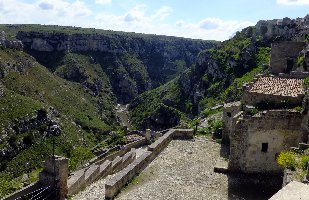
That evening a stop at the Belvedere (a viewpoint at 1,330 foot) on top of the hill on the opposite side of the gorge yielded more orchids. Alas only 10-15 minutes were available and only the immediate vicinity to the carpark was examined.
The first species was Berteloni's Bee Orchid, Ophrys bertolonii, instantly recognised by the bright speculum, and the upturned labellum.
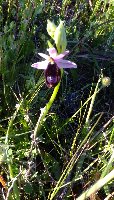 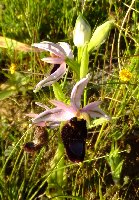
Ophrys bertolonii
Nearby was Ophrys fusca, O. lutea and two, as yet, unidentified species; unfortunately the sun was setting at the time and the light not not kind to my camera. All five species were each represented by a small colony at the site.
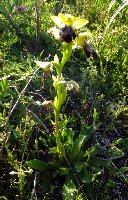 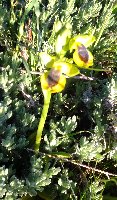 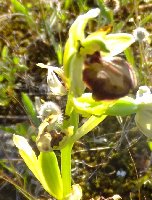 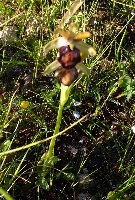
11th April Castell Del Monte
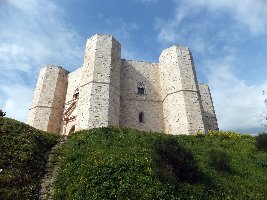 A visit to a remarkable octagon Norman castle in the middle of the region, and I didn't expect to see anything, with the drive and gardens manicured. However the castle is set atop a limestone hill and on the north side between two of the towers was a small colony of Ophrys garganica . The east and south sides also had exposed rocky areas, but no further specimens or other species were found; perhaps the sunshine either dried the sparse soil or other plants out-competed the orchids. We were about 1,500 foot above sea-level. A visit to a remarkable octagon Norman castle in the middle of the region, and I didn't expect to see anything, with the drive and gardens manicured. However the castle is set atop a limestone hill and on the north side between two of the towers was a small colony of Ophrys garganica . The east and south sides also had exposed rocky areas, but no further specimens or other species were found; perhaps the sunshine either dried the sparse soil or other plants out-competed the orchids. We were about 1,500 foot above sea-level.
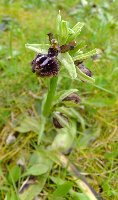 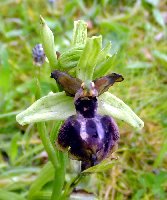
11th April Foggia Services
Not the most likely of places but a small waste patch with limestone chippings supported a number of wild flowers including Ophrys siptonensis. The altitude here was only 150 foot. The identification of this is very tentative. It does fulfill many of the requirements of O. sphegodes, but comparison with examples of that show significant differences. The location lies on the Siponta plain.
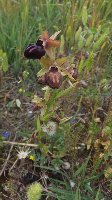 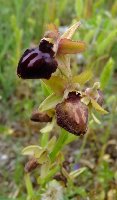
12th April Gargano Peninsula
The Gargano is a large promontory at the northern end of Puglia, and mainly limestone, reaching heights of 800 metres. Essentially it is 20 miles north to south and double that east to west. There are a few well maintained but very winding roads crossing the hills. It is claimed that over 68 species, subspecies and varieties of orchids can be found there, some of them endemic. We had but less than one day and despite the distances and the fact that much of the lower slopes are private land and fenced off, and that suitable parking spaces are not everywhere, we had a fairly successful time there. Much of the area is covered by the Foresta Umbra, so little chance of orchids in April there, but there is also plenty of open areas with exposed limestone outcrops and grassy slopes - garrigue. The first two stopping places yielded nothing, but as we climbed higher the diversity of orchids found increased. We took the SS89 Vieste to Mattera road at first, with three orchid sites examined, and got diverted off that due to road repairs near the end, before taking the un-numbered road from the coast towards Monte Sant'Angelo. It was tempting to stop too often, but we knew similar sites near each other would most likely yield the same species. Access away from the roads themselves was not always possible, but not always needed; the roadsides provided plenty of orchids.
Site 1.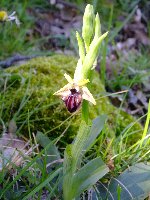 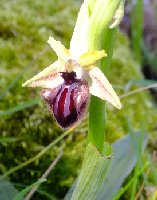
After a couple of non-productive stops a spot by a track leading up to a couple of hill farms seemed a good spot for orchids. Actually though, we were about to give up when a single O. sphegodes was found in the shelter of trackside trees. This was at an altitude of just over 2,000 foot.
Site 2.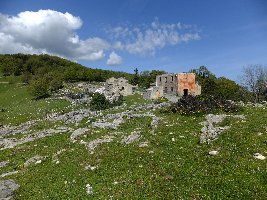
This spot, at 2,100 foot, was even more promising by a small holding and deserted farmhouse, with underlying rock exposed. Three species were found represented by just three plants, not all Ophrys, and they were spread over a wider area. The first find was another Ophrys species. 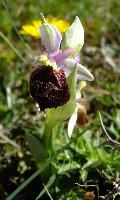 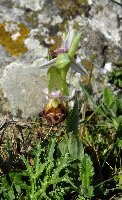 Taking into account the white sepals with a greenish centre line, the pink petals, and the unusual speculum marking on the labellum, the best candidate for this is O. biscutella, Delforge stating that it grows on Gargano and elsewhere up to 4000 feet. It grew within the exposed rocks pictured in the location photo. Taking into account the white sepals with a greenish centre line, the pink petals, and the unusual speculum marking on the labellum, the best candidate for this is O. biscutella, Delforge stating that it grows on Gargano and elsewhere up to 4000 feet. It grew within the exposed rocks pictured in the location photo.
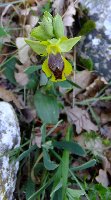
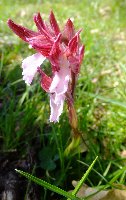 The second specimen was found growing in a clearing between clumps of low shrubs. First glance suggest that it was a Serapias species, but on closer examination it became obvious that it was Orchis papilionacea. This is a highly variable species, and I have not found an image that quite matches this example. However there is no other Orchis (or Serapias) that fits the appearances quite so well. The second specimen was found growing in a clearing between clumps of low shrubs. First glance suggest that it was a Serapias species, but on closer examination it became obvious that it was Orchis papilionacea. This is a highly variable species, and I have not found an image that quite matches this example. However there is no other Orchis (or Serapias) that fits the appearances quite so well.
The third species found was nearby; Ophrys sicula, regarded by some as O. lutea minor. Despite the species name this is not limited to growing in Sicily.
Site 3.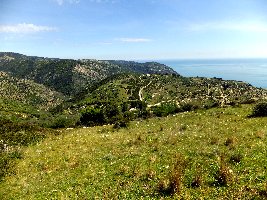
This was small roadside cutting descending back down towards the coast at 1,360 foot, with a bank on one side and a drop on the other. You could hear the bells on the goats from across the valley! This bank provided an almost perfect means of looking for orchids, as one didn't have to look down all the time, and it was populated by the species growing in the fenced off land above. A 300 yard walk along the roadside yielded quite a display of species.
 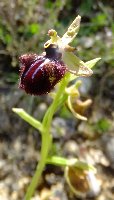
The first species noticed after parking up was Ophrys garganica, or Ophrys incubacea. The latter is considered by some as a variant of the former which explains the indecision. I favour the latter because O. garganica is said to have the labellum hair only on the basal part, and the humps are absent or poorly developed.
Nearby, and also further down the road in a small colony was Ophrys fusca, identified by the shape and curve of the labellum.
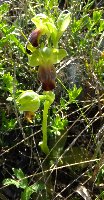 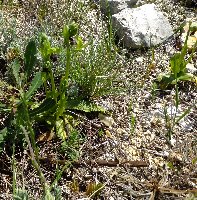
Throughout the stretch of road were examples of Orchis italica and slightly atypical Orchis militaris. Quite delightful to find and to see. Though of similar form and colour, and possessing striped sepals, a close look at the `body-shaped' labella shows the significant differences. O. italica has long tapering `legs', while those of O. militaris are much shorter and blunt ended. Could the O. militaris be a Orchis militaris x italica hybrid? It does not have the long legs of italica, but neither does it have the spotting and colouration of on the labellum of militaris.
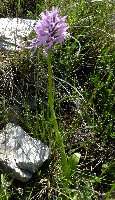 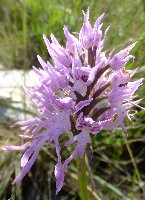 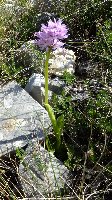 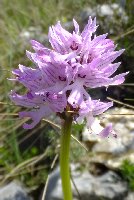
O. italica O. militaris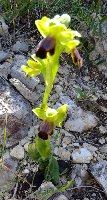 
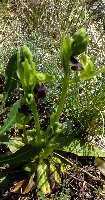 Superficially similar to O. fusca was Ophrys forestieri, (left) distinguishable by the notches in the side of the labellum. Apologies for the poorer quality images here. Superficially similar to O. fusca was Ophrys forestieri, (left) distinguishable by the notches in the side of the labellum. Apologies for the poorer quality images here.
There was also a single example of Orchis papilionacea (right) with just two flowers.
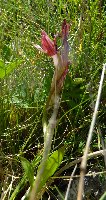
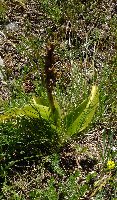 While mid April is perhaps the best time to visit Puglia to see wild orchids, it can be too late or too early for a minority of species. There were numerous examples of Barlia robertsiana which were already setting seed, and at this site there was a Serapias species which wasn't quite in bloom enough to be identified, though Serapias parviflora has been reportedly found by others in roughly the same area. While mid April is perhaps the best time to visit Puglia to see wild orchids, it can be too late or too early for a minority of species. There were numerous examples of Barlia robertsiana which were already setting seed, and at this site there was a Serapias species which wasn't quite in bloom enough to be identified, though Serapias parviflora has been reportedly found by others in roughly the same area.
The Ophrys species are always going to be a bit problematic and this one is quite similar to Ophrys sphegodes, but the yellow rim to the labellum leads me assume that this example is Ophrys araneola
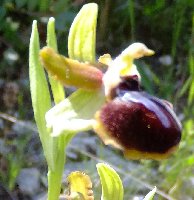
Site 4.
After a diversion and reaching the coast we took the incredibly winding road towards Monte Sant'Angelo, and found a broad open area at 1,425 foot altitude. Here was another spot with a diverse array of orchids in one small area. Immediately we noticed both Ophrys lutea and Ophrys sicula growing together - can you spot both in the middle picture?.
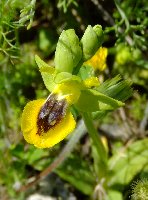 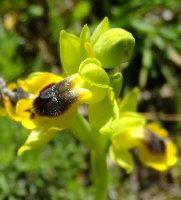 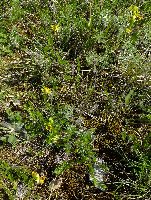
 This next Ophrys has had me baffled. I had hoped the rather complex H shaped speculum would help, but it doesn't. Its a case This next Ophrys has had me baffled. I had hoped the rather complex H shaped speculum would help, but it doesn't. Its a case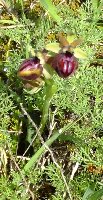 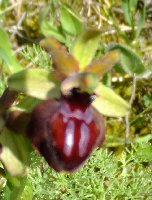 of more saying what it isn't. Against it being O. garganica is the lack of a notch in the tip of the labellum, the lack of overall hairiness, and lack of bumps. The lack of bumps goes against it being O. sphegodes, while the lack of a tip to the labellum goes against O. arachnitiformis. It was growing too far north to be considered O. tarentina. Looking at a range of photos from various authors I think it is closest to O. arachnitiformis. Another specimen may be the same species, or something else. Unfortunately the photos are not quite in focus which makes it rather difficult to see detail, but the colouring is rather spectacular - perhaps and artifact of the sunlight. of more saying what it isn't. Against it being O. garganica is the lack of a notch in the tip of the labellum, the lack of overall hairiness, and lack of bumps. The lack of bumps goes against it being O. sphegodes, while the lack of a tip to the labellum goes against O. arachnitiformis. It was growing too far north to be considered O. tarentina. Looking at a range of photos from various authors I think it is closest to O. arachnitiformis. Another specimen may be the same species, or something else. Unfortunately the photos are not quite in focus which makes it rather difficult to see detail, but the colouring is rather spectacular - perhaps and artifact of the sunlight.
Three more examples of Ophrys that may take some time to come to some decision about regarding identification. The first (leftmost) seems to have the anther detached and attached to the labellum. I had hoped the elongated O shaped speculum on the third would help identification, but it seems to be a sometimes-feature of Ophrys H or II shaped speculi.
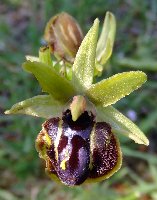 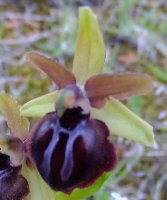 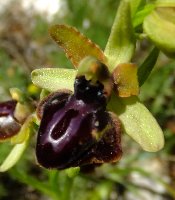
A nice surprise at this site was the presence of a nice colony of rather unpigmented flowered Orchis (Acereas) anthropophora, the Man Orchid, which is rather rare and local in the UK. There was also what was almost certainly a larger Serapias which was a late flowerer. These observations and existing records suggest this was Serapias vomeracea. Also present were a few Orchis italica and Orchis papilionacea.
  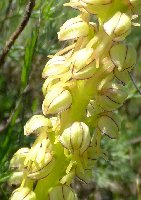 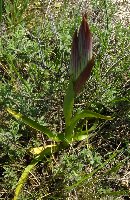
April 13th 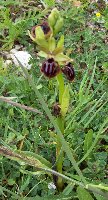
A coach trip with limited stops is not the best way to spot orchids, but the tortuous nature of the roads meant that there were frequent sightings of some species recognizable from the windows. Following the P53 coast road from Vieste to Mattera, in the vicinity above Pugnochiusa there was Barlia robertsonia (recognisable from the large size and maturing seed heads in April), Orchis italica and probably Anacamptis pyramidalis (both recognised by the form, size and flower colour). We stopped a while in Monte Sant'Angelo and on a bit of waste ground near the coach park we found colonies of Ophrys - possibly two species (pictured via a back-up camera due to flat batteries). The first seems to closely match the second unidentified Ophrys species seen at site 4 above.
Leaving the town we took the P528 to cross Gargano as directly as possible to Peschici. Soon after the town, and in meadows for the first few miles large colonies of what were most likely Anacamptis morio (from the size form and colour) were seen. And on the outskirts of Pescici were more B. robertsonia. Travelling along the S89 back to Vieste, and about 4 miles from the coast there was an obvious colony of Orchis (Acereas) anthropophora.
Tentative list of species spotted in Puglia
1. Ophrys sphegodes
2. Ophrys araneola
3. Ophrys bertolonii
4. Ophrys fusca
5. Ophrys forestieri
6. Ophrys lutea
7. Ophrys garganica
8. Ophrys siptonensis
9. Ophrys biscutella
10. Ophrys sicula
11. Ophrys incubacea
12. Ophrys arachnitiformis
13. Orchis papilionacea
14. Orchis italica
15. Orchis militaris
16. Orchis (Acereas) anthropophora
17. Orchis mascula
18. Anacamptis pyramidalis
19. Barlia robertsiana
20. Serapias parviflora
21. Serapias vomeracea
|
